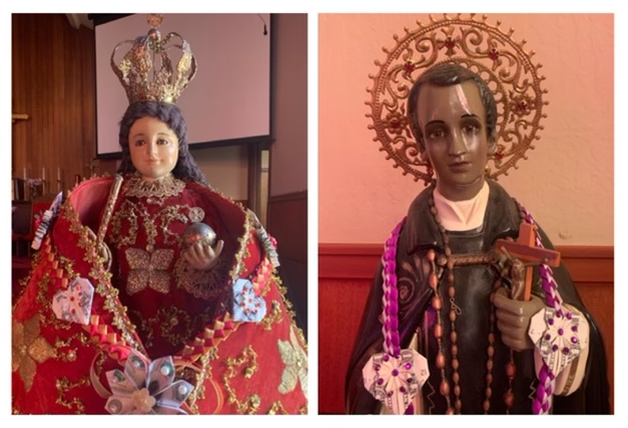History of Holy Child and St. Martin Episcopal Church

On July 21, 1955, the plans for St. Martins Episcopal Church began to take shape under the Rt. Rev. Karl Block, the Bishop of California at the time. The groundbreaking ceremony for the church was on September 6, 1957. The Rev. Henry A. Dick was chosen to be the first vicar; this was the start of a community that was looking for a better life as well as housing following World War II. This community known as Westlake was to be located on the West side of Daly City just south of San Francisco.
Westlake was built by Henry Doelger. Henry Doelger was an Episcopalian and although he didn’t attend church, he provided a beautiful knoll on which to build the church. About a decade after the church was built, he provided the bell for the church’s bell tower. Although Doelger build about half of this area, the following decades saw Callan and Sunstream building the later homes. The area around Doelger’s development had many Episcopalians and St. Martins was the center of that community. The main institutions in the area would be Seton Medical Center, Westlake Mall, and Serramonte Shopping Center along with other local churches. Jefferson High School would be the first high school built in Daly City, but then Westmoor would be built for the Westlake area. There were also five grammar schools in area and a Junior High School, which would provide much of our church school, which by 1963 had over 200 students and the church had over 200 members. There were also members who began coming from Pacifica and the Southern part of San Francisco. By the middle of the 1980’s many of the children had grown up and gone away to college, gotten married and moved away soon. St. Martins could no longer support itself and sought assistance from the Diocese.
St. Barnabas, A Filipino Ministry is born
St. Barnabas’ history goes back to 1906. Under the supervision of Fred T. Foster, it moved its building to the Excelsior District of San Francisco in 1911. The building was pulled by oxen. The demographics in San Francisco began to change into an ethnically diverse city after World War II. As the city began to change so did St. Barnabas. St. Barnabas soon had one of the most diverse congregations in the Diocese with African Americans, Asians, Latinos, Caucasians, and Filipinos as members of the small mission church.
In 1969 St. Barnabas had a very strong Filipino presence and when The Rev. Angus Dunn retired, the first official Filipino-American ministry in the Diocese of California began. With assistance from the Episcopal Asian American Ministry and the Filipino members of St. Barnabas the Rev. Sancho A. Gaerlan was brought in from Texas and St. Barnabas would become the headquarters of the Filipino Ministry in the Diocese. This ministry became the center for making the Diocese aware of the diversity within it. Fr. Gaerlan retired in 1986 due to poor health. He later moved to the Philippines where he continued his ministry until his death in 1994.
In 1987, the Rev. Vito Q. Villalon succeeded Fr. Gaerlan. He was the second Filipino vicar and the Filipinos were second fastest growing ethnic minority and the Diocese approached Fr. Villalon about moving the ministry from its location in San Francisco to St. Martin Episcopal Church in Daly City. In 1991, Daly City had one of the largest Filipino populations outside of the Philippines. The move was made and St. Barnabas and St. Martin became one.
Holy Child and St Martin (HCSM)
In May 1993, St. Barnabas and St. Martin became one, Holy Child and St. Martin. Families from both congregations became charter members of Holy Child and St. Martin Episcopal Church. Rev. Villalon resigned and in October 1997 The Rev. Bayani Rico came from Toronto, Ontario to become the second vicar of HCSM. The church is a cross section of the population. There are now about 10 different ethnic groups with people from the Philippines, European-Americans Peruvians, African Americans, Cubans, Chinese, Japanese and may other ethnic groups
In March 2005, there was a fire in which portions of the church burned. This resulted in massive fire and water damage to the main building. The Sunday services were held in the downstairs fellowship hall for the better part of the next two years until The Rev. Bayani Rico resigned from HCSM due to health reasons.
In October of 2008, the Rev Leonard Oakes became the third vicar of HCSM. Rev. Oakes was installed as the vicar on November 1, 2008, by the Rt. Rev. Marc Handley Andrus. The Rev. Oakes served as vicar until the beginning of 2021. Today the leadership of HCSM is being shared by the Rev. Jureck Fernandez and Rev. Rebecca Goldberg.
Contact
Explore
Holy Child & St. Martin Episcopal Church
Nonprofit Website by Noble
